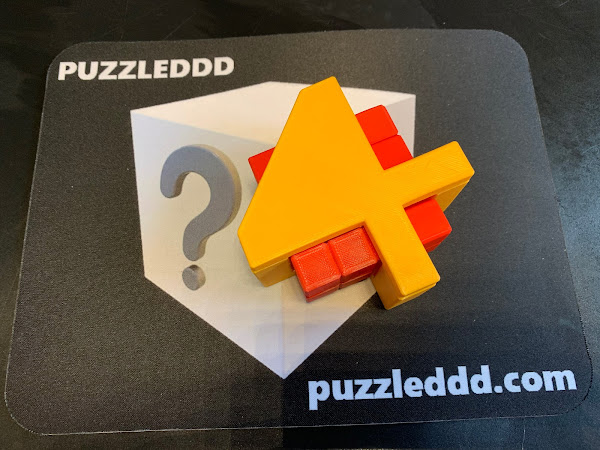Plastic ? Yes, indeed !
Yes, I do print puzzles in plastic. I know it can raise questions or even concerns for some people.Let me try to get some answer !
What I hear sometimes is two types of objection. First of all, from serious puzzlers, that wood is much nicer, you could say even more noble, for puzzles than plastic. Yes, indeed I love puzzles in woods ! But I have a few but...
Wood is nicer and more expensive as well. The price of high quality wood puzzles can be quite high, and very rightly so. It requires exotic woods and special craftmanship, hence the price. 3D printed puzzles are more affordable, not necessarily cheap but more affordable, and can be of high quality as well. I always pay a lot of attention to the quality of my puzzles, and from the feedback I receive, I believe I can be satisfied.
3D printing puzzles is not an industrial process, where you just push a button and then you have 10 puzzles ready for sale (sorry to disappoint some of you). It requires some craftmanship, sure not the same as woodworking, but it requires experience in 3D printing (a lot !), fine tuning, assembling, gluing, testing,... But still, one benefit of 3D printing is that it is easier to reproduce a model, for one copy or for 10, whenever you want. Most often, wood puzzles are produced in batch and after 1 or 2 batches of 50 copies, that's it. I can pretty much keep all my models in the catalog, and you can order an "ancient" model with a new shiny one whenever you want. I can also produce a small series of only 5 copies of a new puzzle, which in woodworking will probably not be affordable.
And a last comment, very important to me, is that 3D printing allows some puzzle designs that just cannot be produced in woods. I really like to design unique puzzles that just have to be 3D printed. Let's take Swiss Cheese and Grape (yes, still a favorite of mine !). There are holes everywhere, with some very specific angles, and holes that connect between 2 cheese pieces to let the steel grape go through (no you cannot just drill 2 holes, you need to add grooves at the junction, I realized that when I threw away my first prototype). It just cannot be produced in woods. Maybe once, with some specific tooling, for a unique piece, but it is impossible to produce a batch (it could actually be produced in aluminium or brass, but the price point is then very different). If I take another example, my Espresso or Caffe Latte puzzles are packing puzzles with round pieces. Sure, it could be done in woods, with a lathe, maybe with a CNC. But that's a lot of work for puzzle craftmen who have all their tools and jigs ready for cubic voxels to adapt just for 2 round packing puzzles. There are much more examples of internal mazes or crazy shapes that would be very difficult or impossible to craft in woods.
Overall, 3D printing has really enlarged the offer of puzzles on the market since a few years. It has brought more affordable puzzles, with much more variety and on-demand availability. It has also freed the creativity of puzzle designers, with different constraints but as well much more possibilities. Some unique and high quality 3D printed puzzles have nothing to envy exotic wood puzzles on the puzzle collectors shelves.
A second objection I hear, which is really important to me, is that plastic is not environmental friendly. It is a valid point, but it can be addressed. First I do print in PLA (polyactic acid), which is a vegetal plastic produced from corn starch. PLA is used as well for some food containers or bags, you may have seen those in supermarkets. I personnaly do not print in ABS, very common plastic in the industry and derived from petroleum products. PLA is biodgradable. I have done my research and I know this point can be controversial, because PLA is biodegradable but it requires specific waste factories to process it. As of today, there are not that many, and they are more common for ABS or PETG, much more common plastic. But still, it is biodegradable and if more vegetal plastic is used in the indystry, more capacity for PLA waste processing will be developped.
Then, I believe that I sell puzzles to collectors, who, at least I hope, do not throw all of them away in the trash can. You could argue that myself as a 3D printer I generate a lot of waste for prototyping. It is true that more often than I would like some print fails or the design fails. But I do not throw that away ! I collect all my PLA waste (actually, it remains reasonnable, I don't like to waste filament) and my 3D printing partner does the same. And last time he has sent all our PLA waste to our favorite filament brand, which will then recycle that in recyled PLA filament. I believe that by doing so, I manage to keep my 3D printing environmental friendly.
I hope you enjoyed the reading, and maybe I was able to convince you ! 3D printing is clearly a growing trend in puzzling, and has its place in the puzzling community.



Comments
Post a Comment